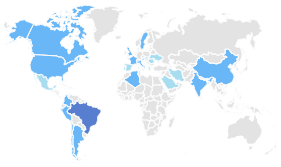Advanced predator-prey Modelling for Work and Employment Scenarios: Brazil in Focus
Resumo
The broad application range of the predator-prey modelling enabled the conjecture that it may be applied to represent the dynamics of the work-employment system in Brazil. The simulations performed showed more chaotic dynamics at the beginning of the time series, tending to less perturbed states, as time goes by, due to public policies and hidden intrinsic system features. Basic Lotka-Volterra approach was revised and adapted to the reality of the study. The aim of this article is to show that the work-employment system in Brazil admits a predator-prey modelling, providing decision makers with generalized theoretical elements that allow to a more accurate and deterministic understanding of the relations between employer and employee in that country.
Keywords: Predator-prey model; Chaotic dynamics; Work-employment
system; Perturbed states; Evolution.
=====================================================================
O amplo campo de aplicação da modelagem predador-presa permitiu conjecturar que esta pode ser usada para representar a dinâmica do trabalho-emprego no Brasil. As simulações realizadas exibiram uma dinâmica mais caótica no início da série temporal, tendendo a estados menos perturbados, com o passar do tempo, devido às políticas públicas e às características intrínsecas do sistema. A abordagem básica de Lotka-Volterra foi revisada e adaptada à realidade do estudo. O objetivo deste artigo é mostrar que o trabalho-emprego no Brasil admite uma modelagem predador-presa, fornecendo aos tomadores de decisão elementos teóricos generalizados que permitem uma compreensão mais precisa e determinista das relações entre empregador e empregado no país.
Palavras-chave: Modelo predador-presa; dinâmica caótica; trabalho-emprego;
estados perturbados; evolução
Texto completo:
PDFReferências
Lotka, A., Elements of physical biology. Williams and Wilkins, Baltimore(1925).
Volterra, V., Leçons sur la théorie mathématique de la lutte pour la vie. , Paris (1931).
Guerraggio, A. and Paoloni, G., Vito Volterra. Birkäuser, Springer Basel AG (2011).
Blasius, B. and Stone, L., Chaotic waves and phase synchronization in spatially extended ecological systems, in D. S. Broomhead, E. A. Luchinskaya, P. V. E. McClintock and T. Mullin, eds., Stochaos: stochastic and chaotic dynamics in the lakes, American Institute of Physics, Woodbury, NY, 5ior02:221-225 (1999).
Holling, C. S., The components of predation as revealed by a study of smallmammal predation of the European pine sawy, Canadian Entomologist 91: 293-320 (1959).
Pekalski, A., A short guide to predator-prey lattice models, Computer Simulations, Computing in Science & Engineering (2004).
Arrow, K. et al., Economic growth, carrying capacity, and the environment, Science, vol. 268 (1995).
Rosenblum, M. et al., Phys. Rev. Lett., 76, 1804 (1996).
DOI: http://dx.doi.org/10.17648/calibre.v7i2.3455
Apontamentos
- Não há apontamentos.
Direitos autorais 2022 Nilo Serpa, José Roberto Costa Steiner
Indexadores, Diretórios, Bases de Dados e Registros (Abstracted and Indexed in):

CALIBRE - Revista Brasiliense de Engenharia e Física Aplicada
ISSN Eletrônico: 2526-4192































